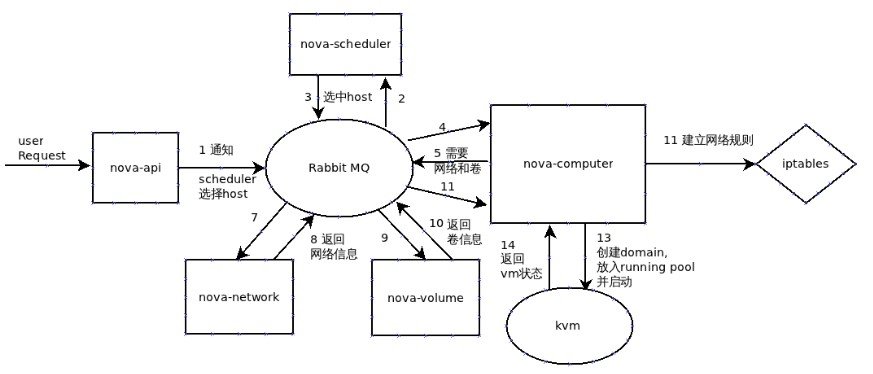 用户发送请求到nova-api,这里有两种: a.通过openstack api 从 server.py's controller.create(): self.helper.create_instance(req, body, self.compute_api.create) create_instance_helper.CreateInstanceHelper() 查表获取基本信息 b.通过ec2 api 从cloud.py.run_instances() 统一调 computer.api.create() 将新的数据插回去
self._ask_scheduler_to_create_instance(context, base_options,
instance_type, zone_blob,
availability_zone, injected_files,
admin_password, image,
instance_id=instance_id,
requested_networks=requested_networks)
2. API 将处理好的数据通过MQ 转发给scheduler .(code from Computer.api)
rpc.cast(context,
FLAGS.scheduler_topic,
{"method": "run_instance",
"args": {"topic": FLAGS.compute_topic,
"instance_id": instance_id,
"request_spec": request_spec,
"availability_zone": availability_zone,
"admin_password": admin_password,
"injected_files": injected_files,
"requested_networks": requested_networks}})
3. Scheduler 获取信息并作出决定 哪一个host 可以来run instance.
def __getattr__(self, key):
return functools.partial(self._schedule, key)
def _schedule(self, method, context, topic, *args, **kwargs):
.......
rpc.cast(context,
db.queue_get_for(context, topic, host),
{"method": method,
"args": kwargs})
LOG.debug(_("Casted to %(topic)s %(host)s for %(method)s") % locals())
4. Computer 从池中获取信息 并让 Networker 去准备一个ip ,让volume 准备卷, 然后初始化相应的信息,例如创建image,映射device,创建domain, 并将domain 放入running pool中 然后就进入等待直到instance的状态变为running. a. networker 分配ip
network_info = self.network_api.allocate_for_instance(context,
instance, vpn=is_vpn,
requested_networks=requested_networks)
def allocate_floating_ip(self, context):
return rpc.call(context,
FLAGS.network_topic,
{'method': 'allocate_floating_ip',
'args': {'project_id': context.project_id}})
b 让 volume 准备卷
bd_mapping = self._setup_block_device_mapping(context, instance_id)
def create(self, context, size, snapshot_id, name, description,
volume_type=None, metadata=None, availability_zone=None):
rpc.cast(context,
FLAGS.scheduler_topic,
{"method": "create_volume",
"args": {"topic": FLAGS.volume_topic,
"volume_id": volume['id'],
"snapshot_id": snapshot_id}})
c call nova.virt.libvirt.firewall.IptablesFirewallDriver 建立网络规则 这里是重头戏,单独开个贴记录下.... d call libvirt 创建domian 并launch
domain = self._create_new_domain(xml)
def _create_new_domain(self, xml, persistent=True, launch_flags=0):
if persistent:
# To create a persistent domain, first define it, then launch it.
domain = self._conn.defineXML(xml)
domain.createWithFlags(launch_flags)
else:
# createXML call creates a transient domain
domain = self._conn.createXML(xml, launch_flags)
return domain
e call virt.libvirt.connetion.spwan 等待
def spawn(self, context, instance, network_info,
block_device_info=None):
..........
def _wait_for_boot():
instance_name = instance['name']
try:
state = self.get_info(instance_name)['state']
except exception.NotFound:
msg = _("During reboot, %s disappeared.") % instance_name
LOG.error(msg)
raise utils.LoopingCallDone
if state == power_state.RUNNING:
msg = _("Instance %s spawned successfully.") % instance_name
LOG.info(msg)
raise utils.LoopingCallDone
timer = utils.LoopingCall(_wait_for_boot)
return timer.start(interval=0.5, now=True)
5 一旦instance的状态改变至running,他就会去通过networker获取网络信息, 这里有几种方式,取决于你的networkManager 转载请保留固定链接: https://linuxeye.com/Linux/755.html |
